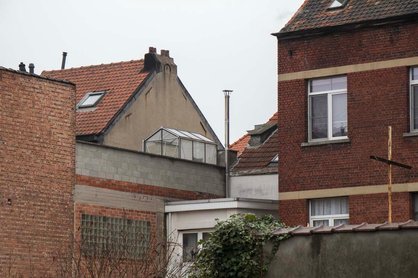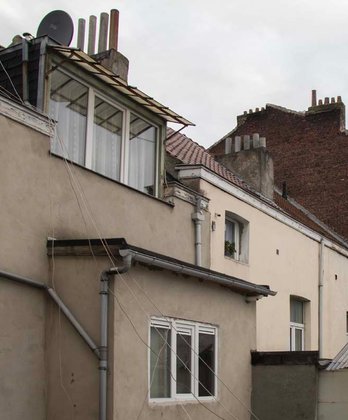
Antoine HORENBEEK
Contents
Understanding an architect's involvement in a permit application
Works exempt from planning permission and architect's involvement
Permit application without architect
Examples of projects without architects in Belgium
Region-specific procedures for permits without an architect
Applying for planning permission without an architect may seem complex, but it's entirely possible to succeed in the process by following clear steps. The key is to gather all the necessary documents and ensure that the file is complete and accurate before submitting it. Many applications do not require the signature of an architect, particularly for small-scale work or internal modifications to a dwelling.
It is important to note that each region may have specific criteria and forms to fill out. Applicants should refer to the official website of their local planning department to obtain the required application templates. In addition, providing accurate information and scrupulously following the instructions given can guarantee smoother, faster processing of the application.
For those considering submitting an application of this type, careful preparation is essential. Checking local requirements, understanding the format of the file, and knowing what deadlines to meet can make a big difference to the success of the application. These steps not only ensure compliance with current legislation, but also ensure that work begins without unnecessary delay.
Architects play a crucial role in land development. They ensure that projects comply with local codes and regulations. Some projects can do without an architect, but this depends on the laws in force.
Architects are often essential for complex projects. He or she ensures that buildings comply with planning and building regulations.
Projects such as the construction of multi-storey residential buildings, or sensitive works such as major extensions, require theinvolvement of an architect. These projects are often subject to a permit and must respect a precise framework
safety and aesthetics. Hiring an architect ensures that projects are well planned and properly executed, avoiding costly mistakes or delays.

Antoine HORENBEEK
There are situations in which an architect architect is not required. The law makes exceptions for certain small-scale projects. For example, the construction of small extensions or minor alterations may not require the help of an architect, but are subject to a simplified procedure.
Some work in rural or less regulated areas may also be exempt. It is important to consult the local regulations local regulations to find out which exemptions apply, and to determine the specific requirements.
In the absence of an architect, you need to understand the legal requirements to avoid penalties and minimize the risk of planning violations.
Some activities do not require planning permission or the involvement of an architect. Such work generally concerns maintenance, temporary installations and minor interior alterations.
Routine maintenance work includes simple activities such as cleaning or minor repairs that do not alter the structure. For example, repainting an interior or exterior wall often requires no permit. Pruning vegetation in a garden, such as pruning trees or shrubs, is also permitted without special authorization when it does not entail significant modifications to the landscape.
Visit minor repairs such as refurbishing window frames or replacing tiles, which do not alter the exterior appearance of a house, do not require a permit.
For temporary structures such as tents or standsno permit is generally required if they remain in place for a limited time, typically less than a certain period defined by local regulations. These structures must respect certain surface area limits surface area and height to be exempt from permits.
The installation of such structures on land must not have a lasting effect on the relief of the ground or compromise public safety. The same applies to temporary fences, provided they do not exceed certain dimensions.
Interior fittings that do not entail structural structural modifications can be carried out without a permit or architect. This includes replacing or placement of movable partitions. Placing new appliances or changing the layout of furniture and equipment, as long as this does not affect the solidity of load-bearing walls, is free.
Changing floors or or applying a new paint color are also examples of activities that can be carried out legally without the need for a permit. In short, as long as there is no demolition demolition or modification of the exterior appearancethese works are generally authorized without administrative formalities.
Planning permission without an architect allows certain minor alterations or constructions to be carried out without the compulsory use of an architect. The criteria to be met and the list of documents to be supplied are essential for obtaining the necessary authorization quickly.
To obtain planning permission without an architect, it's important to check that the project meets certain specific conditions. The project must be small-scale and not affect the building's load-bearing structure.
Exempted work includes small-scale exterior construction or minor modifications, such as the creation or relocation of internal partitions. A change of use is also possible if it does not involve structural risks.
It is crucial to comply with local planning regulations, which may dictate special conditions or exceptions for obtaining planning permission without an architect.
Applying for a permit without an architect requires a number of specific documents. The list includes the official application formcorrectly completed.
It is often necessary to submit a photographic report to illustrate the current state of the space concerned. Construction or modificationplans must be clear, even without an architect's annotations.
The complete file must include all copies and appendices.
At UBEX, we offer comprehensive support for urban planning procedureseven without the intervention of an architect. It's not easy to know which documents to submit, depending on the municipality and region, or how to present your application, let alone produce plans that meet the authorities' expectations. Thanks to our mastery of local and regional regulations, we can help you optimize your applications by providing detailed plans and complete files.
Our documents are designed to meet the requirements of local authorities and facilitate the validation of your project. As a reliable partner, UBEX simplifies the process to increase your chances of success, whether in the Brussels Region, Wallonia or Flanders.
Don't hesitate to call on our expertise to maximize your regularization efforts.
The processing of a permit application without an architect may vary according to the complexity of the work and local regulations. As a general rule, however the processing time does not exceed a few weeksbut each commune may have its own specific timeframe.
The costs associated with obtaining a permit without an architect are generally lower, since they do not include an architect's fee. However, administrative fees for filing the application may apply.
It is advisable to consult communal by-laws for detailed information on the timescales and costs associated with planning permission without an architect.
It is sometimes possible to carry out certain construction projects in Belgium without calling on the services of an architect. These projects include simple constructions that do not affect the stability or aesthetics of the main building.
Small garden sheds and (small) carports are often eligible for planning permission without an architect. These structures do not require major modifications to the plots or intervention on the stability stability. The materials generally used are wood or light metal, which facilitate rapid, low-cost construction.
These projects must not exceed a certain height height (usually three meters) and must be erected at a defined distance from neighboring properties. It is important to consider the visual impact on the facade and to ensure that roofs are made of materials that blend in well with the rest of the building.home.

Exterior annexes for non-residential uses, such as garages or storage spaces, can also be built without an architect. These buildings do not add excessive load to the existing structure.They must, however, comply with certain standards, particularly for solar equipment, if installed.
These constructions must be located away from drainage systems, so as not to compromise the safety of the main structure. Local authorities often determine the possible location on the plot according to precise town-planning rules.
An architect is generally not required for interior renovation work involving mainly cladding or painting. This includes kitchen or bathroom modernization, as long as the modifications do not affect the structural integrity of the building.
No major alterations should be made to load-bearing walls or elements essential to the stability of the building. The materials used must comply with national safety standards and guarantee a pleasant view of the interior . Using an architect means minimizing the risk of poorly thought-out and executed work.
Permit applications without an architect vary from region to region in Belgium. These include specific procedures and unique regulations in Wallonia, Brussels and Flanders.
In Wallonia, applications for planning permission without an architect are often for simple projects. These projects include small house extensions or minor works. The communes handle these requests, and the territorial aspect plays a key role.
A public inquiry may be required, especially if the project has an impact on theenvironment or is located in a protected area. The Code du Développement Territorial (CoDT) guides municipal regulations.
The procedure in Wallonia involves the submission of plans and a detailed dossier. These documents must comply with local planning regulations.
In Brussels, permits without an architect often apply to renovations or small-scale works. The Brussels Environment administration and the municipal departments concerned oversee the regulations.
It is essential to follow the guidelines of the localland-use plan. In some cases, there may be a public inquiry for projects inpublic utility zones.
Dossiers must include full details of the project, with an emphasis onenvironmental preservation and compliance withplanning criteria.
In Flanders, permits without an architect are also granted for projects considered minor. Local authorities handle these applications at local level.
It's crucial to understand the localplanning regulations. Depending on the location, an application may require a public inquiry.
The departments concerned must ensure that all aspects of development comply with environmental and town-planning protection standards. Projects must not disturb thebalance of the area concerned.
Carrying out work without using an architect requires careful preparation and rigorous attention to legal criteria. It's important to be properly informed and to follow the necessary steps to ensure that your project has a positive impact.
To begin with, it's crucial to assemble all the documents required for the permit file. This usually includes detailed plans, a description of the work envisaged, and sometimes specifications.
Setting up a well-structured file can make the process run more smoothly. It's a good idea to follow instructions precisely, and double-check every detail.
Another important feature is to ensure that the criteria applicable to your project are respected. This may include limitations on height, use of materials or the environmental impact of your project.

Antoine HORENBEEK
Before submitting your application, it's essential to contact the local planning authorities. This check may provide information on additional criteria you need to meet, or on legal provisions your project must adhere to.
They can offer valuable advice on the compatibility of your project with existing town planning schemes. If in doubt, it's always best to ask for clarification.
This attention to local details could make the process of obtaining your permit more transparent and rapid. This could avoid potentially costly mistakes.
A planning consultant can be a useful resource. While they can't replace an architect, they can provide valuable support in preparing your file.
They can guide you through the necessary steps and help identify the potential impacts of your project. They are often well versed in legal constraints and expectations.
Thanks to their experience, they can advise on the best way to complete the required documents, and make the process simpler. Hiring a consultant can be a good investment, especially for more complex projects. At Ubex, we can support you even if your situation does not require an architect. Our experts put their experience at your disposal to guide you through your application.

Applying for a permit "without an architect" involves a number of specific criteria and rules in Belgium, particularly in Wallonia and Brussels. It raises questions about the conditions required, the types of work concerned, and the steps involved.
In Wallonia, many works can be carried out without an architect if the impact is limited. This includes minor modifications that do not affect the building's load-bearing structure. Restrictions can vary, sometimes requiring a simple declaration or a permit, depending on the CoDT.
The CoDT specifies that certain small constructions, such as a terrace or garden shed, can be erected without the assistance of an architect. Interior finishing work that does not alter the load-bearing structure is also included. Such work must have a limited impact.
In Belgium, various regulations apply to the surface area of buildings built without an architect. Generally speaking, for homes, the threshold without an architect can be set at around 40 square meters, but it's important to check specific local standards, as these may differ.
The notary is responsible for ensuring that all information relating to infringements is properly disclosed. He must advise the parties on the legal implications and steps required to regularize the situation.
An architect becomes mandatory when the work involves major structural modifications, appearance from the public domain or large-scale projects. This generally includes anything that modifies load-bearing walls, facades or roofs, ensuring the safety and conformity of the project.
Alternatives include the use of standard templates and consultation with planning departments. Specialized companies also offer consulting services for these procedures, while respecting legal constraints. These facilitate the process without exceeding legal requirements. That's what we do at Ubex. With us, you won't be alone when faced with the mountain of forms to fill in and the sometimes complex demands to understand when you're not in the real estate business.
Author : CORNIL Olivier
Contact UBEX today for a free consultation!
Don't let regulatory changes take you by surprise. Anticipate and act with UBEXyour partner in real estate regulation.
Contact Ubex
AddressesUbex
Avenue Louise 523 B1050 Brussels
Chaussée de Marche 482 B5101 Namur
Rue Bois Gotha 98 B4000 Liège
Rue de Bart Haut 6 B6790 Aubange
Beekstraat 6 B9030 Gent
Copyright © SIZE+ srl 2025. All rights reserved.